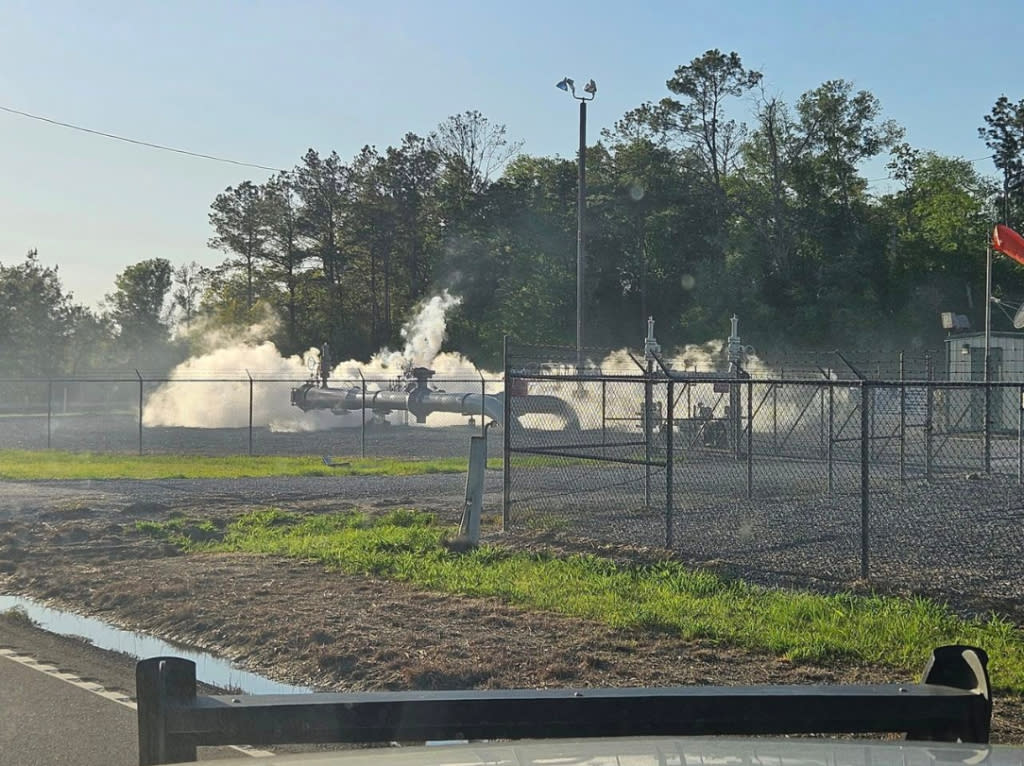Latest carbon dioxide leak raises concerns about safety, regulation

Clouds of water vapor and carbon dioxide gas escape from a CO2 pipeline near Sulphur in southwest Louisiana on April 3, 2024. The harmful gas prompted a shelter-in-place advisory and concerns about pipeline safety and warning systems. (Photo courtesy of Ward 6 Fire Protection District)
It wasn’t the wail of a siren or the buzz of an emergency phone alert that warned Tanya Richard a pipeline near her home was spewing poison gas. The first hint that something was wrong came from her cats, a motley collection of free-roaming felines that fled her property as the dense cloud of carbon dioxide (CO2) rolled over a rural stretch of southwest Louisiana on April 3.
“Normally, I’ve got six kitty cats out here wanting to be fed when I come home,” said Richard, who lives just outside Sulphur, a small Calcasieu Parish town about five miles from Lake Charles. “But they were nowhere to be found. Then I started to notice no cars were passing by. I said, ‘Tanya, something strange is going on.’”
As it turned out, a 2-foot diameter pipeline at a CO2 pump station about a half mile from Richard’s house had ruptured, releasing about 107,000 gallons of the gas, which can cause drowsiness, suffocation and sometimes death. Colorless, odorless, and heavier than air, carbon dioxide can travel undetected and at lethal concentrations over large distances.
The CO2 pipeline network is undergoing rapid expansion as companies invest in the booming carbon capture and sequestration market. With this growth come worries that emergency communities may not be prepared or even aware of the potential for dangerous leaks.
In the outskirts of Sulphur, local police and firefighters could do little more than set up roadblocks and wait for the pipeline’s owner, ExxonMobil subsidiary Denbury Inc., to send repair specialists.
Calcasieu Parish issued a shelter-in-place advisory, urging everyone within a quarter mile of the pump station to close doors and windows and turn off air conditioners, but officials relied mostly on social media to convey the warning. The parish narrowed its emergency alert system to phone numbers listed for addresses within a quarter mile of the station. That amounted to about eight homes – four of which were likely unoccupied, according to parish officials.
The pump station and pipeline aren’t equipped with alarms or other methods of alerting the nearby residents when leaks or other accidents occur.
Several residents in the Sulphur say they received no notice of the leak or became aware of it via Facebook posts more than an hour after the gas began to spread.
“There should have been alarms, and the whole community should have been notified,” said Roishetta Ozane, a community organizer who lives three miles from the station. “I don’t trust the system we have at all.”
GET THE MORNING HEADLINES DELIVERED TO YOUR INBOX
Growing pipelines
The pipeline, acquired by Exxon when it purchased Denbury last year, is part of a 925-mile network stretching through Texas, Louisiana and Mississippi. Across the U.S., more than 5,000 miles of pipeline, including the section running near Sulphur, are primarily used for enhanced oil recovery – a process that injects pressurized carbon dioxide into old or declining oil reservoirs to squeeze out leftover deposits.
Much of the current and predicted growth in the CO2 pipeline network is linked to burgeoning carbon capture technologies, which allow industrial plants to store CO2 underground instead of releasing it into the air. The Biden administration has made carbon capture a key component of its efforts to lower emissions. Billions of dollars in federal grants and tax incentives are up for grabs, spurring a host of projects along the Gulf Coast and a vast expansion of the CO2 pipeline network.
Carbon dioxide pipelines could top 65,000 miles – a thirteenfold increase – by 2050, according to the Congressional Research Service.
Safety regulations aren’t keeping pace, said Kenneth Clarkson, communications director of the Pipeline Safety Trust. The leak near Sulphur is only the latest mishap in an accident-prone network with weak warning and emergency response systems, he said.
“This recent unacceptable leak from another piece of Denbury infrastructure highlights the immediate need for robust and comprehensive carbon dioxide pipeline safety regulations,” Clarkson said. “This incident could have been much worse.”
‘A stark warning’
Local firefighters alerted Exxon about the April 3 leak shortly after it was first reported at around 6 p.m. The company’s Texas-based repair crew arrived an hour and a half later. Wearing masks and air tanks, the crew stopped the leak just before 8:30 p.m. – nearly two and a half hours after it was first reported, according to records from the Ward Six Fire Protection District in Calcasieu Parish. The shelter-in-place advisory was lifted at 9:15 p.m.
No injuries or serious illnesses were reported, parish officials said.
Exxon is still investigating the leak’s cause. In a statement, the company promised to “learn from this.”
“We apologize for any disruption this may have caused,” an Exxon spokesperson said. “In response to any incident, our priority is to help maintain the safety of the community, our personnel, and the environment, and we thank all first responders for their assistance during this event.”
The pipeline has had several accidental releases, including a 1,000-gallon CO2 leak at the same location in 2011, according to the Pipeline and Hazardous Materials Safety Administration (PHMSA).
In 2020, the pipeline had two large-scale leaks in the small Mississippi community of Sataria, about 30 miles from Jackson. One rupture, caused by a mudslide after a hard rain, forced about 200 Satartia residents to evacuate and hospitalized at least 45 people. Emergency responders found people passed out or disoriented and struggling to breathe.
“They found me, my cousin and my brother unconscious, with foam coming out our mouths,” said DeEmmeris Burns, who was fishing with family members near the Satartia leak when the CO2 cloud reached them. “They thought we were dead.”
James Hiatt, a Calcasieu environmental activist, worries about a worse incident in Sulphur or elsewhere along the pipeline, which runs through several parishes.
“These repeated incidents serve as a stark warning,” he said. “It’s crucial that these risks (aren’t) ignored or minimized.”
‘There should be alarms for this’
Despite being outside the shelter-in-place radius, Richard suffered headaches and drowsiness – both of which are symptoms of mild CO2 exposure.
“That night, I got a massive headache, like a migraine,” she said. “Then I felt extremely sleepy, like I’d taken a sleeping pill. I could not get up. I felt…not right.”
Many animals can detect CO2 at lower concentrations than people, which may explain why Richard’s cats ran off. Lab experiments that tested CO2 as a way to euthanize animals showed “innate avoidance” of CO2 at concentrations of less than 1%, according to scientists at the University of California, Berkeley. Humans can’t smell the gas until it tops 30%.
Richard said she shouldn’t have to rely on her cats to warn her when a pipeline ruptures.
“There should be alarms for this,” she said. “I got very upset that most of us had to learn about this on Facebook. Some of the older people around here aren’t on the Internet.”
Social media was awash with misinformation about the leak. Residents initially advised each other that the road closure was related to a traffic accident. When it became clear a pipeline had burst, a few commenters downplayed the danger, saying the gas was harmless or that photos of the leak showed a visible, pale vapor, while CO2 is invisible. But because CO2 pipelines are pressurized, a rapid gas release can produce a water vapor cloud that can travel separately from the carbon dioxide, according to the American Petroleum Institute.
“It seemed like nobody knew what was going on until after it was supposedly over,” said Cindy Robinson, who lives a mile and a half from the leak. “We’re just not prepared for this kind of accident.”
Carbon hub
Already heavily industrialized, Louisiana’s southwest corner has dozens of chemical plants, oil and gas facilities, and a dense network of pipelines. The region is also poised to become a hub for carbon capture and sequestration projects. The Lake Charles area boasts both a dense concentration of carbon-producing facilities and proximity to porous underground rock formations that can store vast quantities of carbon. Companies plan to build many more pipelines connecting the facilities to sequestration sites.
Ozane, the Sulphur community organizer, said PHMSA and other regulators shouldn’t permit additional CO2 pipelines until better safeguards are in place.
“How are they going to manage more pipelines if they can’t safely manage the pipelines they have already?” she asked.
The federal government has no specific standards for transporting CO2. The rules governing the carbon dioxide pipeline network haven’t undergone significant review since 1991, according to the Pipeline Safety Trust.
Federal regulators are considering new CO2 pipeline safety rules that could require leak detection technology and stronger pipeline materials. Details on the proposed rules haven’t yet been released to the public. The process has been repeatedly pushed back, and it’s unclear when the rules might be approved.
Even if new rules are slow-coming, Richard said she’s now far more cognizant of the risks in her community. She frequently passed the pipeline in her car but always assumed it was transporting oil – a substance that’s easier to see, smell and contain during a leak.
“Pipelines are just all around us, but I had no clue some of them had this gas, and that concerns me,” she said. “But I’m aware now. That’s for sure.”
This article first appeared on Verite News and is republished here under a Creative Commons license.

The post Latest carbon dioxide leak raises concerns about safety, regulation appeared first on Louisiana Illuminator.

